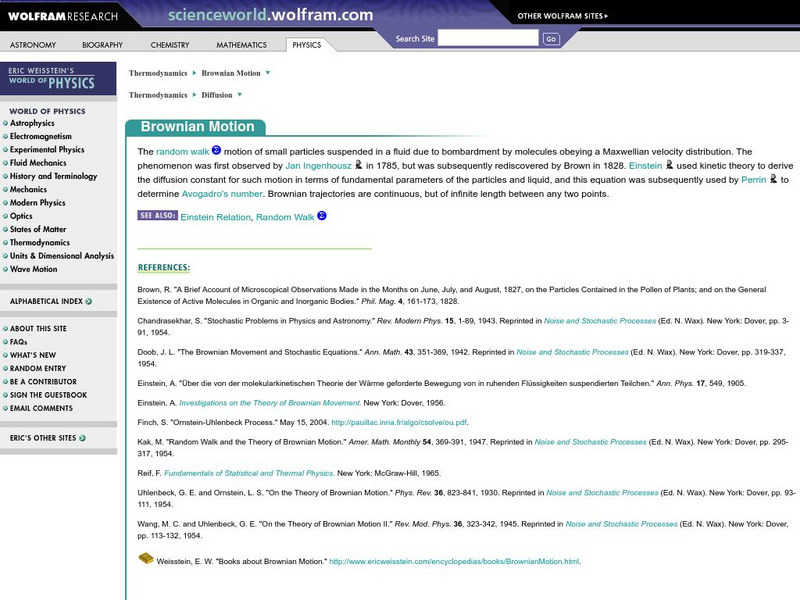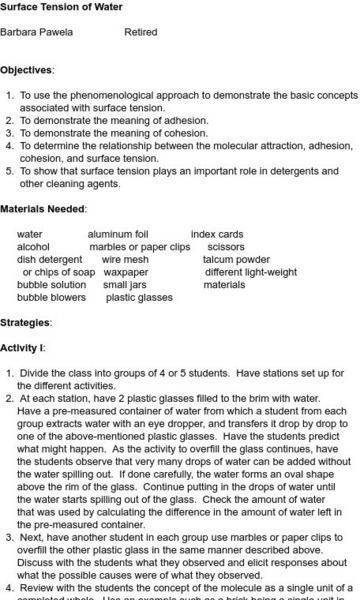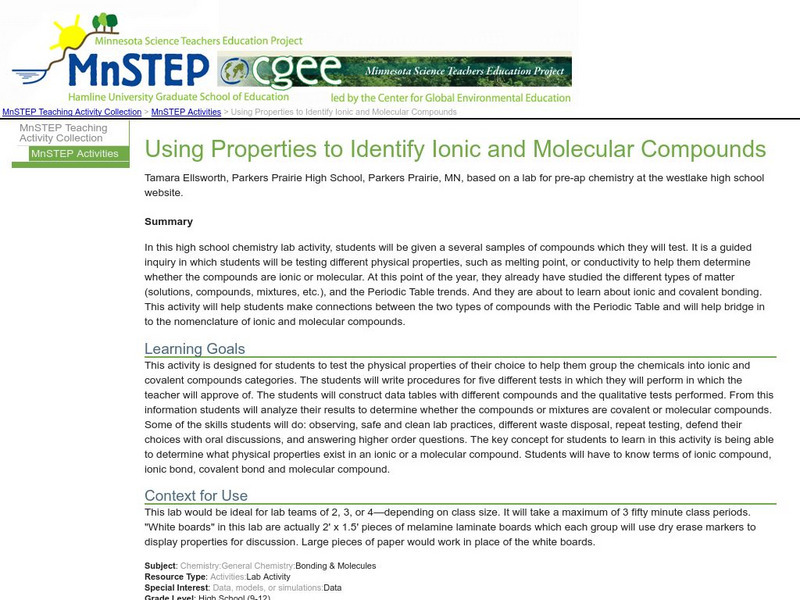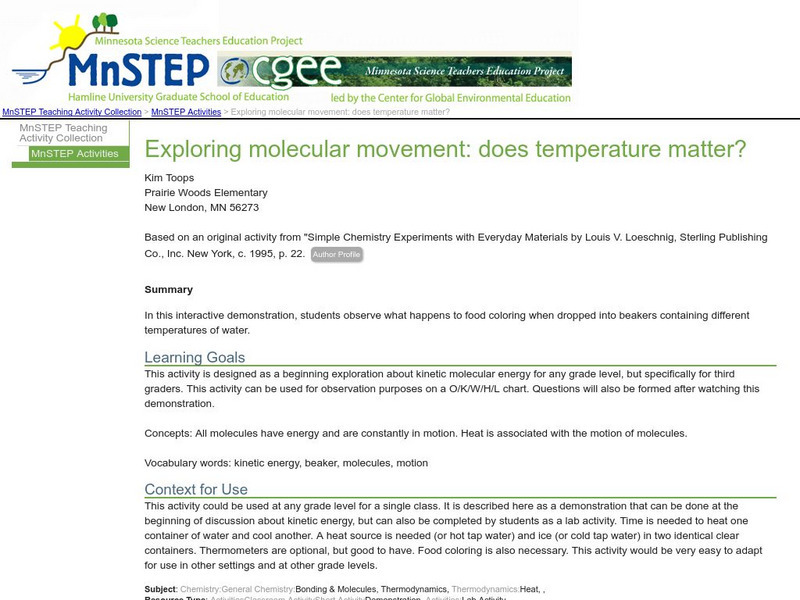Wolfram Research
Wolfram Science World: Brownian Motion
This site from ScienceWorld gives a brief description of Brownian motion. It also goes on with a detailed series of formula derivations utilizing calculus. Links to related topics and definitions are given.
Wolfram Research
Wolfram Science World: Surface Tension
The concept of surface tension is explained and the formula used to calculate it is presented. Includes an example of using the equation, and a table of surfaces tensions is given.
PBS
Pbs: Scientific American Frontiers: Teaching Guide: Tasty Models (5 8)
With this lesson, learners create models of carbohydrates and proteins using pieces of candy in order "to visualize the atomic arrangements of nutrient molecules."
Texas Instruments
Texas Instruments: Common Molecules
Students use StudyCards to practice matching compounds with their chemical formulas.
PBS
Pbs Learning Media: Build a Steroid
In this interactive activity from NOVA, learn about the molecular structure of steroids. See the intermediate molecules that are part of the pathway for synthesizing cortisone from diosgenin.
Science and Mathematics Initiative for Learning Enhancement (SMILE)
Smile: Surface Tension
This is a laboratory exercise which demonstrates the surface tension of water.
Next.cc
Next: Nano Technology
Learn about nanotechnology and why scientists are studying it by completing the three activities. Explore nanotechnology further by clicking on one of the numerous links provided.
Science Education Resource Center at Carleton College
Serc: Plastic Polymers: Investigating Their Flexibility
Young scholars will use their prior knowledge about changes of matter to develop a hypothesis to test the physical properties of materials such as plastic (polymers) and how its chemical properties allow it to have unique physical...
Science Education Resource Center at Carleton College
Serc: Mystery Material
Students will investigate an unknown material by determining its properties and categorizing its state of matter. They will observe how it behaves under different conditions, record their observations, analyze information, and be able to...
Science Education Resource Center at Carleton College
Serc: Molecules, Molecules, Molecules!
In this activity, students will prove the theory that matter is made up of tiny particles called molecules. This experiment will show that these "invisible" molecules are always moving and leaving invisible spaces in between.
Science Education Resource Center at Carleton College
Serc: Using Properties to Identify Ionic and Molecular Compounds
A guided inquiry in which young scholars test different physical properties, such as melting point or conductivity, to help them determine whether the compounds are ionic or molecular.
Science Education Resource Center at Carleton College
Serc: Atoms and Molecules
As part of the introduction to the Periodic Table of the Elements, students will be introduced to the idea of atoms, molecules, and chemical reactions.
Science Education Resource Center at Carleton College
Serc: Exploring Molecular Movement: Does Temperature Matter?
In this interactive demonstration, students observe what happens to food coloring when dropped into beakers containing different temperatures of water.
Simon Fraser University
Chem1 Virtual Textbook: Chemical Composition
Chemical composition is a section of a larger overview on Chemistry, covering a variety of aspects. This section focuses on elements, atoms, compounds, and structure. Examples, formulas, and pictures are provided.
Simon Fraser University
Chem1 Virtual Textbook: Molecules in Motion
As part of the General Chemistry Virtual Textbook, this site continues a study conducted on various topics related to gases. As a specific topic, the site covers an introduction to kinetic molecular theory.
Simon Fraser University
Chem1 Virtual Textbook: Kinetic Molecular Model
The General Chemistry Virtual Textbook, or Chem 1, is broken into several sections covering various aspects of topics related to chemistry. This section deals with the basic components of the Kinetic-Molecular Theory in addition to...
Simon Fraser University
Chem1 Virtual Textbook: Some Consequences of Random Molecular Motion
The General Chemistry Virtual Textbook, or Chem 1, is broken into several sections covering various aspects of topics related to chemistry. This section deals with random molecular motion and topics such as diffusion and effusion.
Wikimedia
Wikipedia: Absolute Zero
Wikipedia offers several paragraphs of detailed information on absolute zero, the lowest temperature that can be obtained in any macroscopic system.
Simon Fraser University
Chem1 Virtual Textbook: Chemical Energy
With an overview of topics related to chemical energetics, this site provides a foundation to a study of thermodynamics and molecules as energy carriers and converters. Topics covered include how molecules take up thermal energy,...
Crescent Public Schools
The Internet Science Room: Net Ionic Equations
Through example problems and explanation, students learn that net ionic equations attempt to show only the particles involved in a chemical reaction.
Ohio State University
Ohio State University: Proteins and Nucleic Acids
This information can be used for exam review or as an introduction. It presents a good overview of the topics with charts, graphs, links, and a quiz.
TED Talks
Ted: Ted Ed: The Invisible Motion of Still Objects
Ran Tivony describes how and why molecular movement occurs and investigates if it might ever stop. [4:44]
Other
Classic Chemistry: Jean Perrin
An excerpt of Perrin's paper "Brownian Motion and Molecular Reality". Includes references.
Other
Wilkes Univ.: Cohesion, Adhesion, and Spreading
Wilkes University provides information on the liquid properties of cohesion, adhesion, spreading and surfactants.























